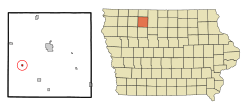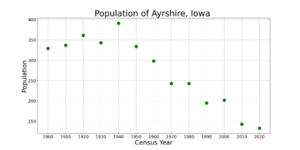Ayrshire, Iowa facts for kids
Quick facts for kids
Ayrshire, Iowa
|
|
|---|---|
|
City
|
|

Location of Ayrshire, Iowa
|
|
| Country | |
| State | |
| County | Palo Alto |
| Area | |
| • Total | 0.22 sq mi (0.56 km2) |
| • Land | 0.22 sq mi (0.56 km2) |
| • Water | 0.00 sq mi (0.00 km2) |
| Elevation | 1,319 ft (402 m) |
| Population
(2020)
|
|
| • Total | 133 |
| • Density | 615.74/sq mi (237.81/km2) |
| Time zone | UTC-6 (Central (CST)) |
| • Summer (DST) | UTC-5 (CDT) |
| ZIP code |
50515
|
| Area code(s) | 712 |
| FIPS code | 19-04105 |
| GNIS feature ID | 0454296 |
Ayrshire (/ˈɛərʃər/) is a city in Palo Alto County, Iowa, United States. The population was 133 at the 2020 census.
Contents
History
In the 1880s the Des Moines and Fort Dodge Railroad (later part of Minneapolis and St. Louis Railway), having reached Fort Dodge, began building to the northwest. In October 1882 the rails reached the location of Ayrshire, and a depot was built the following month. The railroad had acquired 80 acres for a townsite, and by 1883 several businesses had been established.
Ayrshire was incorporated on September 20, 1895.
At one time it had two banks, two grocery stores, blacksmith shop, livery stable, creamery, hotel, at least two barber shops; Lutheran, Catholic, Methodist and Baptist churches; five gas stations, grain elevator, two cafes, a locker plant, a pharmacy, a lumber yard, two beer halls and several other businesses. It had both a Catholic and a public high school. The Catholic high school closed in 1947. The lower grades closed in 1968. The public school closed in the spring of 1982. The public school mascot was the Ayrshire Beavers.
In 1972, the town drew national attention for having the youngest mayor in America. Jody Smith was nineteen when he was elected mayor.
The rail line, by then part of the Chicago and North Western Railway, was abandoned in the 1980s, and torn up.
The town celebrated its Quasquicentennial in 2007.
Geography
Ayrshire is located at 43°2′19″N 94°50′5″W / 43.03861°N 94.83472°W (43.038506, -94.834712).
According to the United States Census Bureau, the city has a total area of 0.21 square miles (0.54 km2), all land.
Demographics
| Historical populations | ||
|---|---|---|
| Year | Pop. | ±% |
| 1900 | 329 | — |
| 1910 | 337 | +2.4% |
| 1920 | 361 | +7.1% |
| 1930 | 343 | −5.0% |
| 1940 | 391 | +14.0% |
| 1950 | 334 | −14.6% |
| 1960 | 298 | −10.8% |
| 1970 | 243 | −18.5% |
| 1980 | 243 | +0.0% |
| 1990 | 195 | −19.8% |
| 2000 | 202 | +3.6% |
| 2010 | 143 | −29.2% |
| 2020 | 133 | −7.0% |
| Source: and Iowa Data Center Source: |
||
2020 census
As of the census of 2020, there were 133 people, 70 households, and 32 families residing in the city. The population density was 615.9 inhabitants per square mile (237.8/km2). There were 80 housing units at an average density of 370.5 per square mile (143.0/km2). The racial makeup of the city was 97.7% White, 0.0% Black or African American, 0.0% Native American, 0.0% Asian, 0.0% Pacific Islander, 0.0% from other races and 2.3% from two or more races. Hispanic or Latino persons of any race comprised 4.5% of the population.
Of the 70 households, 25.7% of which had children under the age of 18 living with them, 22.9% were married couples living together, 14.3% were cohabitating couples, 32.9% had a female householder with no spouse or partner present and 30.0% had a male householder with no spouse or partner present. 54.3% of all households were non-families. 41.4% of all households were made up of individuals, 20.0% had someone living alone who was 65 years old or older.
The median age in the city was 44.8 years. 25.6% of the residents were under the age of 20; 6.0% were between the ages of 20 and 24; 18.8% were from 25 and 44; 29.3% were from 45 and 64; and 20.3% were 65 years of age or older. The gender makeup of the city was 50.4% male and 49.6% female.
2010 census
As of the census of 2010, there were 143 people, 75 households, and 34 families residing in the city. The population density was 681.0 inhabitants per square mile (262.9/km2). There were 95 housing units at an average density of 452.4 per square mile (174.7/km2). The racial makeup of the city was 100.0% White.
There were 75 households, of which 20.0% had children under the age of 18 living with them, 30.7% were married couples living together, 12.0% had a female householder with no husband present, 2.7% had a male householder with no wife present, and 54.7% were non-families. 52.0% of all households were made up of individuals, and 24% had someone living alone who was 65 years of age or older. The average household size was 1.91 and the average family size was 2.88.
The median age in the city was 48.8 years. 21.7% of residents were under the age of 18; 4.9% were between the ages of 18 and 24; 18.2% were from 25 to 44; 30.1% were from 45 to 64; and 25.2% were 65 years of age or older. The gender makeup of the city was 52.4% male and 47.6% female.
Population trends
The number of residents decreased from 202 in 2000 to 143 in the 2010 census, less than half the population a century earlier, 329 in 1900 and 337 in 1910.
Education
Ruthven-Ayrshire Community School District serves the community. It was a part of the Ayrshire Community School District until July 1, 1983, when it merged into Ruthven-Ayrshire.
See also
 In Spanish: Ayrshire (Iowa) para niños
In Spanish: Ayrshire (Iowa) para niños


